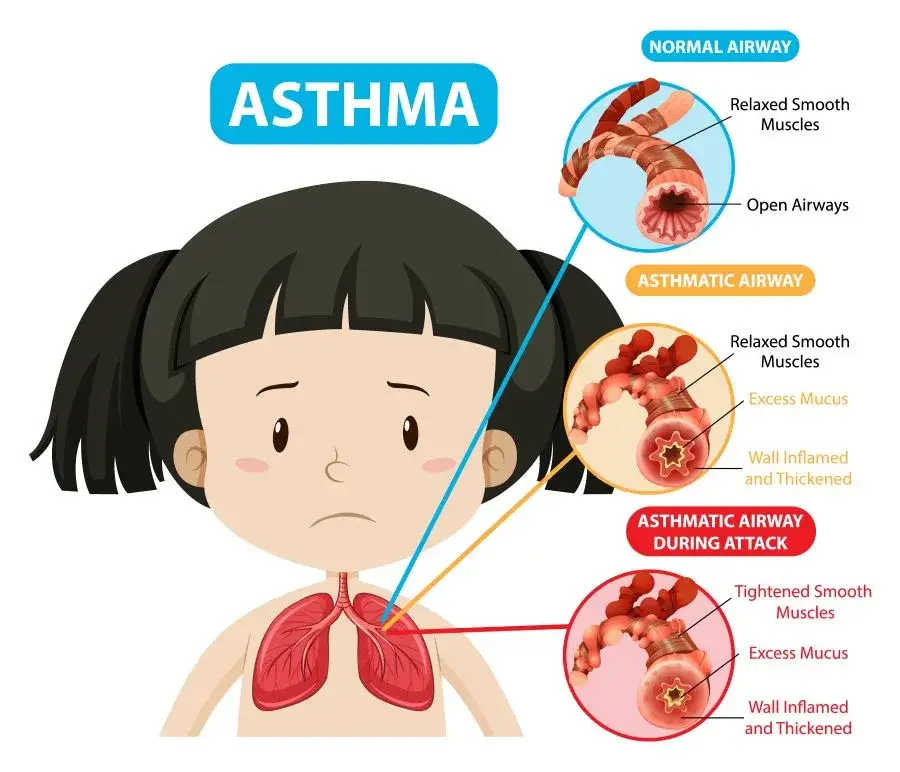Table of Contents
Overview:
- Childhood asthma is a chronic lung disease that significantly affects the airways, essential tubes that facilitate the movement of air in and out of the lungs. This condition causes swelling and narrowing of these air passages, reminiscent of a pinched straw, causing difficulty breathing along with wheezing, coughing, and chest tightness. Triggers such as allergies can aggravate these symptoms, resulting in asthma attacks that can be life-threatening, which can develop rapidly or slowly over time.
- Typically during a child’s developmental years, especially before age 5, when the immune system is still maturing, asthma can significantly impact a child’s daily routine. This can lead to missed school days and, in severe cases, may require hospitalization. Therefore, it becomes important to have a well-planned asthma treatment plan to manage and minimize the effects of this condition on the child’s life.
- Asthma is alarmingly prevalent in children and is the primary cause of chronic disease in this demographic. In the United States alone, approximately 7.5 million children are affected by asthma, and this rate is continuously increasing. Missing school and parental absence from work are responsible for the increase in asthma cases in children.
- Several factors contribute to the increased prevalence of childhood asthma. These include increased exposure to allergens such as dust, increased air pollution and second-hand smoke. Additionally, reduced exposure to childhood diseases, which might otherwise strengthen the immune system, and lower rates of breastfeeding may also play a role in this increase.
Symptoms and causes:
- Childhood asthma symptoms can manifest differently in individuals and vary from case to case. Common symptoms are frequent coughing, shortness of breath, chest tightness, breath sounds when breathing, signs of fatigue or irritability These symptoms can also intensify during an asthma attack, causing severe coughing, severe breathing problems, discoloration of the mouth, lips and fingernails or they are
- Although the exact cause of asthma is rare, it usually manifests in childhood due to the continued development of a child’s immune system. Various factors such as genetics, exposure to allergens, and early viral infections affecting the respiratory system can influence the development of asthma It is important to note that asthma itself is not contagious and cannot spread from person to person.

Risk factors and complications:
- Several risk factors contribute to a child’s likelihood of asthma, including allergies, family history of asthma or allergies, frequent respiratory infections in early childhood, low birth weight, exposure to tobacco smoke before or after birth, sex assignment at birth, and specific ethnic backgrounds or living environments characterized by high air pollution levels or urban settings.
- Poorly managed asthma can lead to serious complications, ranging from frequent hospitalizations, emergency department visits to permanent lung damage to missed school days or activities as a result of inadequate control of asthma symptoms, affecting a child’s overall well-being.
Diagnosis and testing:
- Diagnosis of asthma in children, especially under six, presents challenges due to overlap of symptoms with other respiratory conditions and limitation in doing specific tests Usually pediatrician evaluates child’s medical history, performs physical examination, asks about family history to diagnose asthma, frequency and nature of symptoms Referral to specialist for further evaluation It can be necessary.
- Diagnostic tests for childhood asthma may include lung function tests to measure lung capacity, allergy skin tests or blood tests to identify triggers, and chest x-rays to rule out other conditions.
Management and treatment:
- Effectively managing childhood asthma involves creating an asthma action plan in collaboration with health care providers. This plan details the appropriate use of asthma medications, steps to prevent worsening symptoms or asthma attacks, and guidance for seeking emergency care when needed To ensure this is accessible to school staff and other carers involved in the child’s routine, caregivers understand this plan, his And compliance is essential.
- Childhood asthma medications consist primarily of rapid-relief and long-term control medications. Quick-relief medications aim to alleviate symptoms during an asthma attack, while long-term control medications focus on preventing attacks and reducing airway inflammation
- The effectiveness of asthma medications generally outweighs their potential side effects, which can include skin reactions, oral thrush, increased heart rate, nervousness, or weight gain but serious side effects may require consultation with a health care provider for dosage adjustments or alternative medications.
Prevention and prognosis:
- Although prevention of childhood asthma is challenging due to its uncertain origins, measures can be taken to reduce risk factors. These include a mold-free home environment, reducing exposure to air pollution and promoting healthy lifestyle habits such as maintaining a healthy weight
- The prognosis of childhood asthma is long-term management rather than cure. With appropriate treatment and preventive strategies, most children can lead active lives without significant disruption due to asthma symptoms. A well-managed episode of asthma has minimal symptoms, no missed school days or urgent medical visits, and minimal side effects from medications.
Life with asthma:
- Regular visits to healthcare providers are essential for children with asthma, especially if they have specific risk factors or recent exacerbations. Understanding and following an asthma action plan is critical to effectively handling asthma attacks, ensuring prompt relief and necessary medical treatment when needed
- Parents and caregivers should be alert for signs of an asthma attack in children, administer relief medication according to an action plan, and seek immediate medical help if symptoms persist or worsen Emergency calls for severe wheezing, coughing, difficulty breathing, or discoloration of skin, lips, or fingernails. Moving the room is essential
In conclusion:
- childhood asthma, although a challenging condition to manage, can be effectively controlled through comprehensive treatment planning, proactive prevention strategies and regular healthcare monitoring Understanding symptoms, triggers, and appropriate response allows children with asthma to live full lives despite the challenges this chronic condition poses.

FAQs.
Q. What is childhood asthma?
A. Childhood asthma is a chronic lung disease that significantly affects the airways, essential tubes that facilitate the movement of air in and out of the lungs. This condition causes swelling and narrowing of these airways, reminiscent of pinched straws, causing difficulty breathing along with wheezing, coughing, and chest tightness.
Q. When does childhood asthma occur?
A. Typically during a child’s developmental years, especially before age 5, when the immune system is still maturing, asthma can significantly impact a child’s daily routine. This can lead to missed school days and, in severe cases, may require hospitalization.In the United States alone, approximately 7.5 million children are affected by asthma, and this rate is continuously increasing. Therefore, it becomes important to have a well-planned asthma treatment plan to manage and minimize the effects of this condition on the child’s life.
Q. Can we live with asthma?
A. Regular visits to healthcare providers are important for children with asthma, especially if they have specific risk factors or their condition has recently worsened. It is important to understand and follow an asthma action plan to effectively deal with asthma attacks, ensuring quick relief and necessary medical treatment when needed.
Parents and caregivers should be alert to the symptoms of an asthma attack in children, administer relief medication according to an action plan, and seek immediate medical attention if symptoms persist or worsen.



Thanks designed for sharing such a pleasant thought, article is fastidious,
thats why i have read it entirely